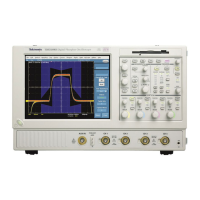285
Only one mask standard is active at any one time. If you have one mask selected or enabled and
then select a new mask, the new mask replaces the previous mask. You cannot test to multiple
standards simultaneously.
Autofit and Persistence Interaction
The Autofit function moves the waveform vertically and horizontally in a mask to reduce the
number of segment hits within a mask. If persistence is set to infinite or variable, each Autofit
waveform movement clears existing persistence data. If Autofit makes frequent waveform
movements, there may be little or no displayed waveform persistence data.
Segments and Mask Hits
Each mask can have a maximum of 16 segments. Segments can overlap. The number of mask hits
is the sum of all hits in all segments, regardless of whether or not segments overlap. For example,
if a waveform crosses over an area where two segments overlap, both segments will count the
waveform hit.
Vertices
Each segment can have a maximum of 50 vertices. Vertices are numbered counterclockwise, with
vertex one generally located at the bottom left of each segment. The active (selected) vertex is
indicated by an X. The instrument automatically assigns numbers to vertices during mask creation
or editing.
Mask Margin Tolerance
Mask margin tolerance moves the mask segment boundaries by the specified percentage. Negative
margins reduce the size of the segment, making it easier to pass a mask test. Positive numbers
make it harder to pass and allow you to perform margin testing on your design. If a user defined
mask has more than three segments, turning on mask margins generates an error message. Turning
mask margin tolerance off redraws the mask segment margins to their default values, but leaves
the numeric value as it is, allowing you to quickly toggle between default and user-set margin
values.
Standards and Bandwidth
When the instrument system bandwidth (which includes the instrument, attached probes, and/or
cabling) falls into the range of 1.5 to 1.8 (0.8 for optical signals) times the data signal bit rate, the
third harmonic of the data signal is significantly attenuated. The instrument displays useful
qualitative information, but quantitative rise-time measurements under these conditions may not
be accurate.
For example, a FC531E Elec mask has a bit rate of 531.25 Mb/s. 1.5 to 1.8 times this value is a
range of 796.5 MHzBW to 955.8 MHzBW. Therefore, you should not use an instrument with less
than 1 GHz measurement system for making quantitative rise-time measurements of this standard.
When just the instrument bandwidth falls within 1.5-1.8 (0.8 for optical signals) times the bit rate
of a selected mask standard, the instrument displays the message "Consider system bandwidth
when testing at this bit rate." in the status area above the graticule.
Levels Used in Taking Eye Measurements
All eye-diagram measurements are based on the power level, the voltage level, or the time
locations of edges within each acquisition.

